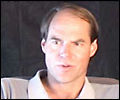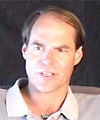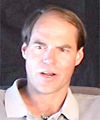| "...As for the camera, we think there's a good possibility that the camera is still up there. And the film in that camera could offer the definitive clue..." |
 In an exclusive interview with MountainZone.com from his home in Washington State, a relaxed Eric Simonson reflected on the recently concluded 1999 Mallory & Irvine Research Expedition on Mount Everest. Simonson, leader of the expedition, shared his thoughts on the unexpected success of the team's high-profile search, and expanded on some of the intriguing details.
In an exclusive interview with MountainZone.com from his home in Washington State, a relaxed Eric Simonson reflected on the recently concluded 1999 Mallory & Irvine Research Expedition on Mount Everest. Simonson, leader of the expedition, shared his thoughts on the unexpected success of the team's high-profile search, and expanded on some of the intriguing details.
The veteran climber expressed his pride in being involved with the expedition, and gave credit to the individual members, who as a team got along remarkably well.
| "...As for the camera, we think there's a good possibility that the camera is still up there. And the film in that camera could offer the definitive clue..." |
"I think you make deposits in the karma bank," Simonson said. "I've had some good ones, and some that haven't been so good. For all those expeditions that aren't successful, or have personality conflicts, I guess one that goes particularly well is the payoff. We worked exceptionally well together, perhaps because we had all climbed together before.
| STREAMING VIDEO Eric Simonson | |
 | |
| REALPLAYER modem speed (28k) (56k) (T1) RealPlayer | |
| WINDOWS MEDIA modem speed (28k) (56k) (T1) Windows Media | |
"The whole experience exceeded our expectations. We told a great story of the 1924 climb, and brought that story to the world. We conducted a thorough search, and made real progress on bringing new clues as to what really happpened 75 years ago. And we were able to conduct a technical evaluation of the Second Step, and Conrad Anker's efforts there shed real light on that situation.
"One thing people don't realize is how much risk was involved. Whenever you're working at 27,000 feet, it's risky. And we were under pressure to do as good a job as we could, and we didn't take that lightly."
As to why many of the climbers assumed —until the facts proved conclusively otherwise— the body they discovered on May 1 was probably that of Andrew Irvine, Mallory's 22-year-old climbing partner, Simonson said it had a lot to do with the preconceived notions that the climbers brought with them.
"I personally had come to believe that Mallory and Irvine had split up, and that we'd find Mallory's body much higher on the mountain, and that we'd probably find Irvine near Camp VI. It just goes to show how important it is to have actual fact to go on, rather than speculation. I'd like to think that we did bring important new information from which we can make a better determination as to what happened."
| STREAMING VIDEO Eric Simonson | |
 | |
| REALPLAYER modem speed (28k) (56k) (T1) RealPlayer | |
| WINDOWS MEDIA modem speed (28k) (56k) (T1) Windows Media | |
"The area that we had thought had the most potential for results was west of the old Chinese site for Camp VI. Altogether, we wanted to search a place about the size of a dozen football fields, so it's a large area. But with five people looking, we were able to cover quite a lot of the ground. All the climbers were in radio communication. After two hours, Conrad found Mallory at the lower end of the search area, while making a traverse through quite a steep area. The rest is history."
Summit day itself held two important events, Simonson said. Thom Pollard and Andy Politz made a more thorough search of the area around Mallory's remains to look for evidence of the camera, while Anker and Dave Hahn climbed toward the summit.
"Pollard and Politz actually had trouble relocating the body," Simonson said, "because of the snow. But they were able eventually to find the body, along with Mallory's watch, and to conclude positively there was no camera in the vicinity. We wanted to conduct that kind of a search—even though it meant Thom and Andy would not be able to try for the summit—to make it unnecessary for other climbers to return to the body. As for the camera, we think there's a good possibility that the camera is still up there. And the film in that camera could offer the definitive clue."
![]() [click to hear and read it]
[click to hear and read it]
Simonson described what for him was a nerve-wracking summit day as he worried over the weather and the progress of Conrad Anker and Dave Hahn as they climbed to the top.
| "As for the camera, we think there's a good possibility that the camera is still up there. And the film in that camera could offer the definitive clue..." |
Simonson concluded by saying that he and his team learned so much this year that by returning to the upper slopes of Everest they'll be able to conduct a more meaningful search for Irvine and other artifacts.
"Certainly, it's our intention to go back and finish what we began this
spring," Simonson said. "We think what we've learned will prepare us
for another search, and we hope this time to focus on finding the
camera, which could be the definitive evidence of the success or
failure of their climb. And since we're talking about the first ascent
of the highest mountain on earth, it has huge historical significance,
and significance from the standpoint of human endeavor and challenge.
It's a terrific story and we think that it's not unrealistic to think
about going back to write the final chapter."
![]() [click to hear and read it]
[click to hear and read it]
— Peter Potterfield, MountainZone.com Staff
![]()
Read more about Eric Simonson in the
Everest Forum